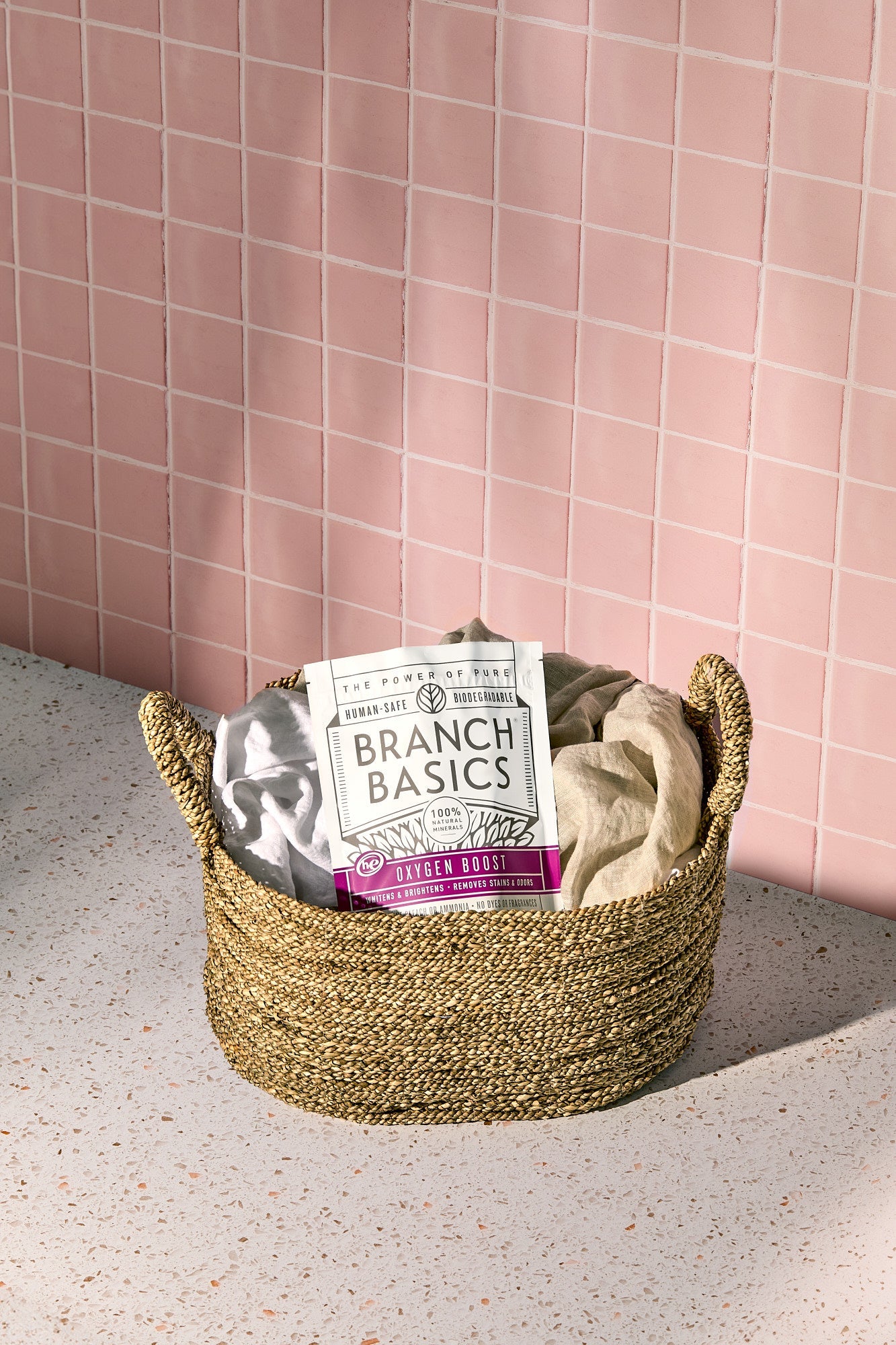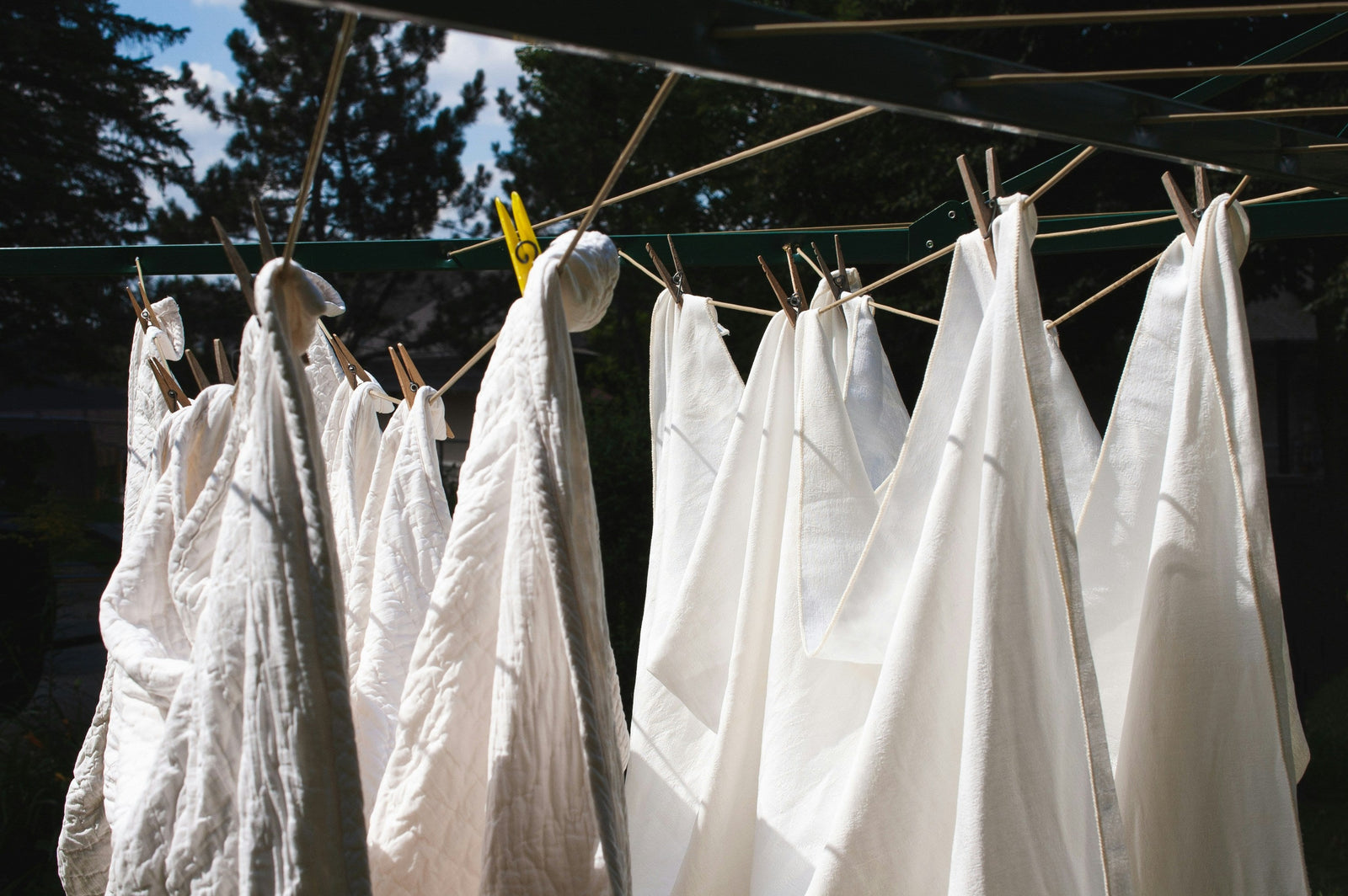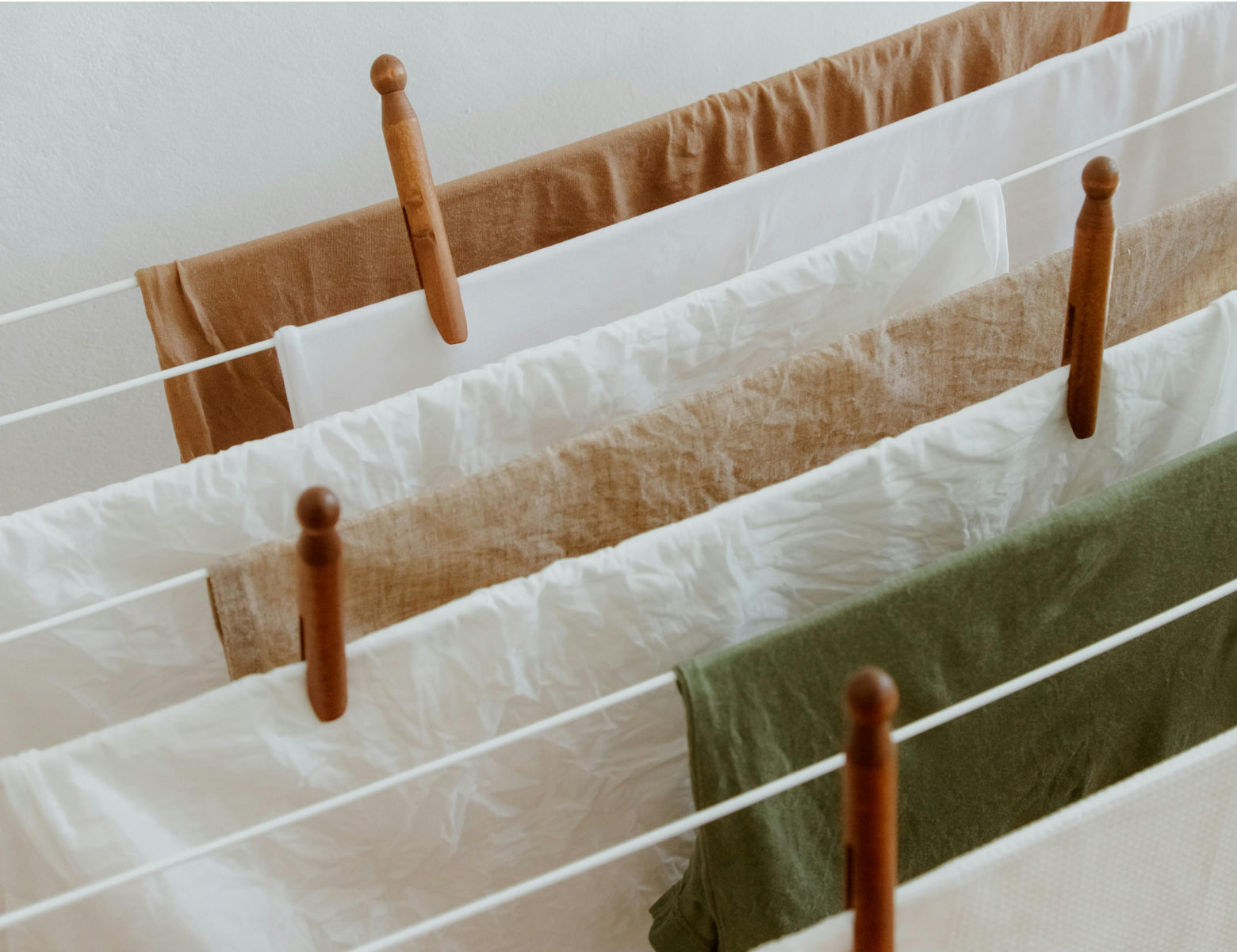Laundry Bleach Alternatives: 7 Human-Safe and Environmentally Safe Options

Is there really an effective human- and environmentally-safe laundry bleach alternative out there?
Yes! There are several bleach alternatives that will whiten and brighten your laundry and remove stains without exposing you to the harms of chlorine bleach.
Most of us know bleach is poisonous (it’s one of the top causes of household chemical poisonings in children),[1] but many choose to continue using it while taking certain precautions.
What you may not know is that bleach reacts and generates chlorinated Volatile Organic Compounds (aka: VOCs). These toxic fumes are extremely harmful and considered human carcinogens.
In other words, bleach is highly hazardous to your health, your family's health, and the environment, even from passive exposure.
Plus, it’s completely unnecessary and, in our opinion, has no place in a healthy home.
At Branch Basics, we believe your laundry routine should be just as clean and safe as the rest of your home.
The alternatives we will discuss below are designed to provide you with the cleanest laundry possible, without the harmful chemicals found in bleach.
7 Laundry Bleach Alternatives
So, how do you get along without bleach?
By using these seven environmentally safe and human-safe laundry bleach alternatives.
Let's dive in.
1. Baking Soda
There are dozens of uses for baking soda (sodium bicarbonate)—from baking to DIY cleaning and personal care products. But did you know it also makes a great laundry bleach alternative?
To whiten, brighten, and soften your clothes, add half to 1 cup of baking soda directly to your wash and launder as usual.
For stain removal, make a simple paste of baking soda and water and rub directly on the stain with a scrub brush. Let dwell for at least 10-15 minutes. Rinse and repeat as needed.
Larger stained items or set-in stains can be soaked in a basin of water with half to 1 cup baking soda. Then launder as usual.
As an added bonus, baking soda also helps boost laundry detergent performance in hard water.
Learn more in: Impact Of Soft And Hard Water On Laundry.
2. The Sun
Sunshine is a powerful weapon for removing stains, accelerating off-gassing, whitening whites, and burning off synthetic fragrance in clothing and garments.
To sun your clothing, sheets, comforters, cloth diapers, etc. simply place them in direct sunlight for a few hours and watch those stains fade away.
A few things to keep in mind:
- Natural sunlight will fade colors, so it is best to use on white or light-colored clothing OR to turn colored clothes inside out.
- For optimal stain removal, put clothes outside when the sun is at its strongest. This is usually at high-noon to about 3PM.
- The sun’s rays will be strongest in the summer, but they will also work in other seasons (just not as dramatically in most geographical locations).
- Always shake out your clothing, etc. before bringing it inside (nature does harbor some insects that may accidentally attach themselves to your garments).
To learn more about the benefits of sunning, check out:
- Take Advantage Of Summertime: How To Outgas (Or Offgas) & Remove VOCs
- How Remove Perfume Smell And Heavy Fragrance From Clothing
3. Vinegar
The acetic acid in distilled white vinegar has a bleach-like effect. It works to brighten, remove stains, and soften clothes without harming fabrics.
To use, add half a cup of vinegar to the final rinse for brighter, whiter, softer clothes.
For brightening dingy whites (100% cotton):
Add 1 cup of vinegar to a big sinkful/basinful of hot water. Soak socks, sheets, undershirts, etc., overnight and launder as usual.
Distilled white vinegar can also be used to keep dark clothing from becoming dull. It works by removing residues that can cause fading of colors over time. To use, add about half a cup to the final rinse cycle.
You can also use distilled white vinegar in place of bleach to clean and detoxify your washing machine.
To learn more, see: 12 Ways to Use Distilled Vinegar In Your Home.
Finally, vinegar is one of nature’s most effective disinfectants when used with hydrogen peroxide (used separately and stored in separate bottles).
This can come in handy when cleaning your laundry room.
PLEASE READ THE FOLLOWING BEFORE USING VINEGAR AND PEROXIDE:
Even though they’re safe cleaning products, vinegar and peroxide can create harmful and irritating fumes when mixed and stored together.
Thus, it is essential they be stored and used in separate bottles.
We like to attach a trigger sprayer directly to our hydrogen peroxide bottles (3% in the brown bottle), then designate a spray bottle for vinegar.
- To use, clean the surface with Branch Basics All-Purpose.
- Next, spray the surface liberally with either the vinegar or peroxide (the order doesn’t matter). Let it sit for 5-30 minutes. Wipe with a microfiber cloth.
- Repeat the same step with the other bottle.
4. Branch Basics
At Branch Basics, we have two safe and effective laundry detergents to choose from.
Both our liquid Concentrate and Laundry Detergent have their unique benefits, and the choice ultimately comes down to personal preference.
Our Laundry Detergent powder is incredibly convenient and simple to use, requiring just one scoop per load with no additional products needed. It also performs well in cold water, saving energy and preserving fabric integrity.
Secondly, our Laundry Solution uses our liquid Concentrate model, where you mix water with the Concentrate in a Laundry Solution bottle and add a scoop of our Oxygen Boost for extra whitening and stain-fighting power.
Parents love Oxygen Boost for soaking soiled baby clothing and kids’ clothes (think blow-outs, grass stains, baby food, paint, crayons, etc.), and it’s great for pet stains too.
This mineral-based powder can be used directly in the washer and/or combined with Laundry, All-Purpose, or Bathroom as an awesome stain remover.
See our User Guide for directions on how to use Oxygen Boost as an effective bleach alternative.
It is always essential to test an inconspicuous area of fabric to make sure the Oxygen Boost does not lighten or impact the clothing.
For safer and natural laundering tips, see Branch Basics Laundry Instructions, our Stainmaster Guide, and check out our Laundry Kit and Laundry Detergent.
Unsure which detergent to choose?
See: Comparing Branch Basics Laundry Detergent Vs. Laundry Dilution: What’s The Difference?
5. Lemon Juice
The natural citric acid and enzymes in lemon juice make it an effective whitener and stain-remover for surfaces, clothing, and more.
To use on stains, combine lemon juice with salt directly on the stain and agitate. Let sit for 15-30 minutes, rinse, and repeat if needed or launder.
For oil or grease stains, apply straight lemon juice to the stain, let dry, and wash.
Since lemon juice has a bleaching effect, be sure to test it on an inconspicuous place before doing a full application. Take care with colored fabrics.
6. Hydrogen Peroxide
If you’re used to using bleach to wash your whites, you will love hydrogen peroxide.
It brightens and whitens like bleach, without wearing down fabric fibers over time. Plus, there’s no offensive smell.
To use on whites (not colors!), add 1 cup 3% hydrogen peroxide to your wash (in the bleach cup) along with your favorite natural, human-safe detergent.
We also like to keep this handy for reusable menstrual pads or getting blood out of anything white.
Learn more about why we love using hydrogen peroxide as part of a human-safe cleaning routine in: How To Use Hydrogen Peroxide for Safer Alternative for Cleaning, Disinfecting, Laundry, & More.
7. Salt
We’re not big fans of table salt for food (pass the pink, sea, or Himalayan salt, please!). However, salt’s powerful absorbent properties make it a great stain remover.
Plain table salt can be used in place of bleach or other stain removers for:
- Wine: Blot up as much as you can, then put a pile of salt on the stain to absorb the rest. Launder as usual.
- Blood: Rinse the garment, mix salt with cold water to form a paste, rub onto the stain, let dwell 10-20 minutes, rinse. You can also make a salt-water solution and soak garments in that—just make sure it’s cold when you use it.
- Grease/oil: Apply salt and lemon juice directly to the stain. Let dwell at least 30 minutes. Launder as usual.
- Sweat stains: Combine 4 tablespoons salt with a gallon of water and use directly on stains.
- To prevent clothing from freezing on the clothesline, add a pinch of salt in the final rinse.
Get more helpful natural stain removal tips in: Natural Stain Remover Rescue! How To Remove 7 Of The Toughest Stains Naturally
The Dangers of Bleach
As bleach is used in cleaning, laundry, etc. its fumes emit chlorinated compounds which can produce organochlorines (OC), which are known endocrine-disruptors, neurotoxins, and carcinogens.
New research has also linked passive household exposure to an increased risk of respiratory illnesses and other illnesses in children.[1]
Regular use is also associated with an increased risk of COPD, irritation of nose, throat, and mouth mucous membranes, and deterioration of the esophagus, lungs, and respiratory system over time.[2]
Bleach can become a deadly gas when mixed with ammonia, vinegar, drain cleaners, alcohol, hydrogen peroxide, dirty water high in organic matter (think laundry water, mop water, etc.), and other household cleaning products.
In other words: bleach is extremely hazardous to your health, the health of your family, and the environment.
Plus it’s completely unnecessary and, in our opinion, has no place in a healthy home.
Learn more in: Is Sodium Hypochlorite (Bleach) Toxic? The Dangers And Alternatives
Human Safe Cleaning with Branch Basics
Giving up bleach can seem hard, but once you try out these safer laundry bleach alternatives, you’ll realize it’s entirely unnecessary.
But bleach isn’t the only toxic product lurking in most laundry rooms.
Detergents, fabric softeners, stain removers, boosters, and dryer sheets contain some of the most toxic chemicals in American households.
Which is why the laundry room is the most potentially toxic room in the house.
Here’s the good news: you have the power to change that. And we’re here to help.
Branch Basics has two human-safe, MADE SAFE, cruelty-free biodegradable, plant- and mineral-based laundry detergents to choose from:
- Branch Basics Laundry Detergent (a water-less formula that performs exceptionally well in hard water)
- Branch Basics Laundry Solution (a liquid laundry soap made using our signature Concentrate in the refillable bottle)
We also offer Oxygen Boost, a mineral-based, two-ingredient laundry booster, stain remover, scouring agent, and bleach alternative, and wool dryer balls.
For more information about how to detoxify your laundry room and create a healthier home (and why), see: How To Toss Your Toxic Laundry Detergent.
References:
- https://oem.bmj.com/content/72/8/602%20%20
- https://www.merckmanuals.com/home/lung-and-airway-disorder

Marilee Nelson
Marilee Nelson is an Environmental Toxins expert who has spent nearly 30 years advocating for the chemically-sensitive and chronically-ill. She is a Board Certified Nutritionist, Certified Bau-Biologist and Bau-Biology Inspector and specializes in Food As Medicine. She has helped thousands of families and individuals identify, heal and recover from toxic exposures and is on a mission to revolutionize the way American families view their health.








